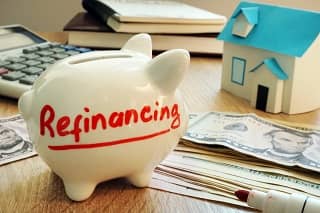 Consistently low mortgage rates continue to provide refinance opportunities for homeowners nationwide. Lower mortgage rates bring new chances for homeowners to refinance, while also allowing potential homebuyers to qualify for larger mortgage loans without increasing their monthly payment.
Consistently low mortgage rates continue to provide refinance opportunities for homeowners nationwide. Lower mortgage rates bring new chances for homeowners to refinance, while also allowing potential homebuyers to qualify for larger mortgage loans without increasing their monthly payment.
Before mortgage rates rise too steeply and shut out your refinance opportunity, here are seven reasons to refinance now:
No. 1: New opportunities exist
Each time mortgage rates fall, the pool of potential refinance customers grows. While the old rule of thumb was to wait until interest rates fell two percentage points below your existing rate before you refinanced, the current rate environment suggests consumers do not need to wait to have a two-percent gap before they move forward. In fact, the rate threshold in which you can refinance and still save is much lower than two percent. If you refinance a two-year-old, $200,000 30-year fixed-rate mortgage from 3.5% to a new 3% 30-year loan, your monthly payment will drop by almost $88 per month, and you'll save more than $6,200 in interest cost over the life of the new loan -- and that's even after considering typical closing costs of about 2% of the loan amount.
No. 2: Current mortgage rates are extremely low
Even as mortgage rates have firmed a bit, they continue to remain near historic lows. Economic concerns at home and abroad, central bank policies and a still-low inflation environment continue to keep the lid on any increases in mortgage rates. But unless global economic conditions worsen, it will be hard for mortgage rates to go much lower than they already are, so there's not a lot of reason to wait to refinance if the numbers are already favorable for your situation. That's not to say that mortgage rates won't be low for a while yet, or even still historically favorable, but time may be running short for grabbing a loan with a rock-bottom rate.
No. 3: You can do a no-cost refinance
Patrick Cunningham, vice president of Home Savings and Trust Mortgage in Fairfax, Virginia, says a "no-cost refinance" can provide financial benefits even if the mortgage rate difference is smaller than it would be in a traditional refinance since you are financing the closing costs and fees into the rate and/or loan amount.
"No-cost refinances" -- actually, no-out-of-pocket-cost-refinances -- typically see you trade paying loan closing costs for a slightly higher-than- market mortgage rate. Although this means your monthly savings are smaller, it's also true that they begin right away without any closing-cost recovery period. As an alternate, you can use a little of your home equity to cover the cost -- this will increase the amount you owe but you won't need to put up any cash to refinance.
HSH's Tri-Refi refinance calculator can help you decide the best way to pay your refinance costs -- out of pocket, by taking out a bit of equity or by using a "no-cost" option.
No. 4: Lending conditions have eased
Mortgage lenders and mortgage insurance companies have slightly loosened credit standards, says Tom Shaw, vice president of marketing for Carrington Mortgage Services in Santa Ana, California.
According to the Federal Reserve's latest Senior Loan Opinion Survey, banks reported a moderate easing of standards for mortgage loans, trimming back overlays and becoming more willing to make jumbo mortgages and more.
That's not to say that any borrower can get a mortgage. You'll still need good credit and solid income and asset strength, but if your credential are a little toward the margins, lenders may allow you a bit more leeway and accept your application.
Lenders may also accept alternative documentation for income, or rely on the strength of your assets to help you qualify. If you don't have much equity, Fannie Mae and Freddie Mac even offer programs that allow homeowners to refinance loans at 97 percent loan to value (i.e. just 3 percent equity). While more of course is better, you don't need a huge equity stake to refinance.
No. 5: A "streamline refinance" may make refinancing painless
Not all borrowers opt for conventional loans, and first-time homebuyers and those with less-stellar credit scores often utilize the FHA program. FHA qualifying can be easier; the FHA doesn't use risk-based pricing, so FHA mortgage rates are lower for borrowers than they would be for a conventional loan if their credit isn't top notch.
One additional benefit of having an FHA-backed loan is that the FHA offers a streamline refinance program, with no requirements for appraisal of the home, no income verification and no credit score review. Essentially, you're swapping an old loan term for a new one with a lower rate, and that can take the hassle out of refinancing.
That said, if you have a pretty recent mortgage and your lender is also the servicer of your loan, they may offer you a streamline arrangement, too. You should check with your loan's servicer -- the number and website are on your monthly statement -- and see if such a deal might be available to you. Even if it is, that doesn't mean it's a great deal -- you'll still need to shop around.
No. 6: You can change your loan term
"Interest rates on 10, 15 and 20-year home loans are lower than rates on 30-year loans," says Shaw. "With a shorter loan term you pay less interest over the life of the loan and pay off your loan in faster."
The downside is that your payments will likely be higher, but how much higher depends on your loan balance and how far along in your original mortgage you are already.
For example, if you've been paying down a $300,000, 30-year fixed-rate loan at 5 percent for 10 years, your balance is now $244,026. Refinancing that balance into a 15-year loan at 2.5 percent will raise your monthly payment by less than $17 and shorten your remaining loan term by five years, saving nearly $94,000 in interest cost.
"If you're in an adjustable rate mortgage that will adjust in a year or two, this would be a good time to shift to a fixed-rate loan so you get to extend the advantage of low interest rates," says Shaw.
You may also want to consider consolidating your first mortgage and a home equity line of credit into one mortgage before interest rates rise, suggests Shaw.
No. 7: You have more home equity
Since rising home values are returning producing rapid equity gains for many homeowners, refinancing can make sense with even a small difference in your interest rate because you might be able to eliminate your private mortgage insurance, says Cunningham. You can also refinance from an FHA to a conventional mortgage to eliminate mortgage insurance payments, as long as you have sufficient equity.
More home equity also means you won't need to bring cash to the table to refinance. Furthermore, interest rates can be slightly lower when your loan-to-value ratio drops below 80 percent.
With current mortgage rates low and home equity on the rise, it’s a perfect time to refinance your mortgage to save not only on your monthly payments, but your overall interest costs as well.
Next Steps: Ready to refinance? Be sure to research current mortgage rates and lenders in your area and plug your numbers into HSH's Should I refinance my mortgage? calculator to see how much refinancing can save you.
(Image: Klh49/iStock)



